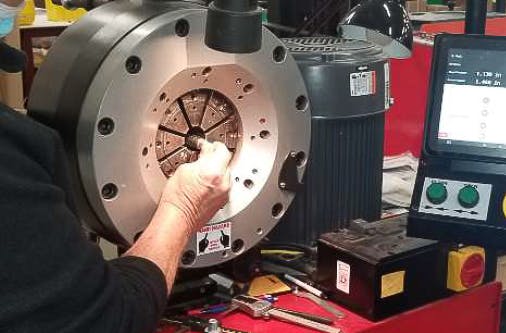How to Properly Crimp Hydraulic Hose Fittings

Image Description: An image of a person preparing a crimping machine for hydraulic hoses
Tools and Components Required
Choosing the right tools for the job separates you from the amateurs and reflects the level of professionalism in your craft. They are essential to the job at hand, organizing components beforehand and ensuring the level of safety required for the job.
You have the choice of using power tools or hand tools as per your discretion, but make sure you know how to use them properly such that the quality of work does not get impacted. It is worth mentioning, though, that power tools will give you better results and cut down on assembly times.
Never forget safety when fabricating hose assemblies. You'll be working with dangerous tools and equipment that present multiple hazards like electrocution, ocular trauma, hearing impairment, and cuts and lacerations. Make sure you wear the necessary protective equipment like gloves, ear defenders, and safety glasses.
Make sure you have all your measurement and marking tools on hand before you start working on the job. This will help prevent any distractions when you're working on the job, leading to fewer errors and better results.
Selecting the Right Fitting
Consult a crimp spec chart to determine which permanent hose fitting is most appropriate for your hose's internal diameter. You might need to consider the strength, corrosion resistance properties, and material when selecting the appropriate fitting.
Cutting the Hose
Before cutting the hose, you need to consider the total length of the hose assembly required. The total length includes the part of the fitting that does not overlap the hose. So account for these lengths in the total length of the hose assembly and keep in mind tolerances when cutting the hose.
Cut the hose such that the end is perpendicular to the length of the hose. If you're using a cutting machine, then it shouldn't be a problem. Make sure that the end doesn't deviate more than 5O from the normal.
Cleaning the Hose
Cutting the hose may introduce metal, rubber, or polymer fragments inside the hose. Make sure you clear them out using compressed air to force out any residue; otherwise, these fragments can contaminate your hydraulic system and cause obstructions. Alternatively, you can flush debris out with a pressure washer, but make sure to dry the inside of the hose with alcohol or other compatible solvents.
Prepping the Hose
You may need to skive the hose end to insert the hydraulic hose fitting. Skiving is the removal of outer layer material via a wire brush or a specialized skiving tool. It depends on the fitting you use to bring the outer cover to the correct skive diameter or till the wire mesh or spiral reinforcement layer. Also, make sure it is skived to the correct insertion depth. After this process, make sure the surface is clean to attach the fitting.
Attaching the Hydraulic Hose Fitting
Your permanent fitting can be of two types: A single component, where the ferrule and stem are attached to each other, or a two-component, where the ferrule and stem come separately. If you're using the single component, then gently tap the stem into the inner tubing using a mallet, making sure that the outer cover and reinforcement layer sits between the stem and ferrule. If you use a separate ferrule and stem fitting, make sure you select the appropriate ferrule. Place it on top of the prepped cover and gently tap in the stem component. In both cases, ensure that the stem and ferrule reach the correct insertion depth.
Crimping
Once the unfinished assembly is ready, consult the crimp specifications to select the appropriate die for your crimping machine. Place in the crimping machine and place your hose assembly in between it. Set your machine to the specifications in the crimp chart and let the machine press the hydraulic hose fitting to make a finished assembly.
Inspect
Inspect the finished hose assembly, making sure there are no imperfections, and the hydraulic hose fitting is crimped to the correct insertion depth. Measure the outer diameter using a vernier caliper by placing it between the ridges of the crimped fitting. Verify that the hose is up to spec, and you're done!